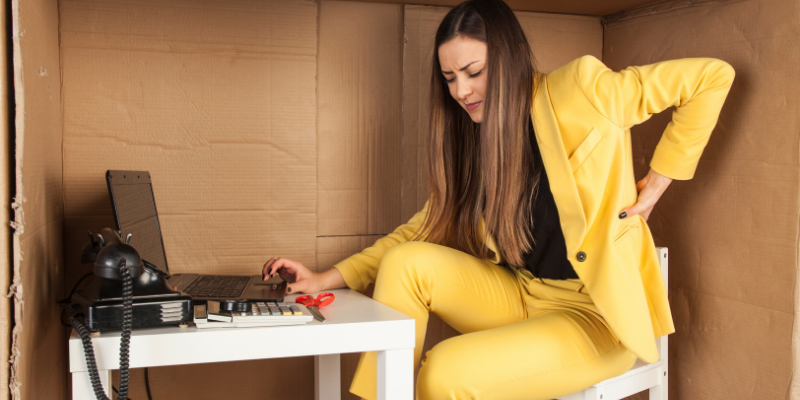In this blog post, I’m going to share with you some work from home back pain solutions and ergonomics tips for working from home to make sure that your workstation is set up correctly and safely, so you can succeed without fatigue.
[ez-toc]
Common Causes of Back Pain
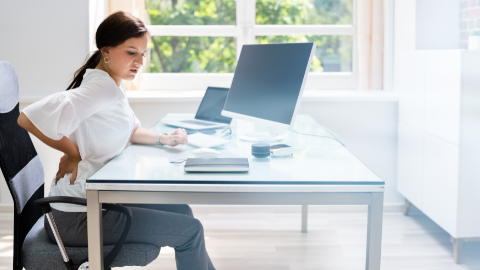
In the United States, 8 out of 10 people experienced low back pain at some point in their lifetime.
Low back pain is the second most frequent reason for doctor visits after the common cold. And it’s the leading cause of job-related disabilities.
When you neglect your posture and continually round your back while sitting or standing for prolonged periods, you can set yourself up for back pain.
Prolonged Sitting
Sedentary jobs that require endless hours of sitting in awkward postures with your back flexed forward can overstretch the muscles and distort the vertebrae, putting unnecessary pressure on your intervertebral discs.
If you’re sitting without proper low back support in a static posture without taking breaks, you could potentially strain your back or end up with a bulging or herniated disc.
Herniated Discs
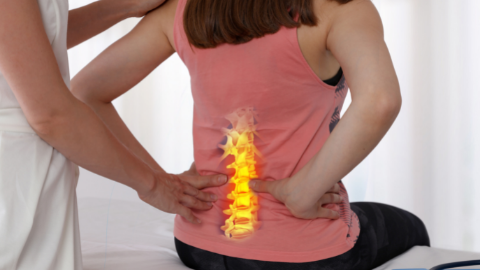
A herniated or slipped disc happens when a tough outer layer of the disc degenerates or sustains a trauma and cracks, allowing some of the nucleus pulposus, a jelly-like disc center, to protrude out of the disc into the spinal canal.
Herniations are most common in the fourth or fifth lumbar vertebrae. This weak spot lies directly under the spinal nerve root putting direct pressure on the sciatic nerve causing radiating pain, tingling, and numbness down the legs.
Poor Standing Posture
Standing to work requires more energy than sitting and can put a tremendous strain on the circulatory system. When you stand for long periods in a non-neutral, awkward posture, the curve in your lumbar spine, referred to as lordosis, can become excessive. And this, too, can result in leg swelling, varicose veins, muscle fatigue, and back pain.
Lift In The Power Zone

Lifting objects with a rounded back can put unwanted pressure on the vertebral discs.
When you increase the distance between the hands and the body, you increase the stress on your lower back.
Keeping the body upright, avoiding back flexion, and maintaining a natural lordotic curve are better options when lifting heavy objects around the house. You want to stay in what’s referred to as the Power Zone.
Just bend your elbows at 90 degrees, and you are in the power zone. The more times you can work in your power zone, the less stress and fatigue you’ll feel on your body.
Warning Signs and Symptoms
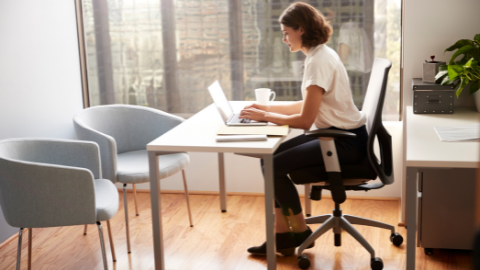
An awkward seated posture is precarious if combined with long periods of sitting and an unsupported low back.
When you remain in the same seated posture for a long time, your blood flow slows down, and the muscles in your back can start to become fatigued.
When your body is tired or sore, your risk of injury increases, and your productivity and accuracy decrease.
How To Sit In A Neutral Position
When you work in neutral postures, you reduce stress on your muscles and joints, which decreases your risk of getting injured.
You know that you’re sitting correctly with a neutral posture when:
- The ears are in line with your shoulders.
- Head, neck, and trunk are facing forward.
- Shoulders are relaxed and slightly pulled back.
- Elbows are closer to your body and bent at a 90-degree angle.
- The back is flush against the chair’s back.
- The S curve of your lower back is supported.
- Your knees are level or slightly lower than your hips.
- There’s no pressure on the back of your knees.
- Your feet are resting flat on the floor or a footrest.
If you’re experiencing back pain or discomfort, there’s a good chance it’s connected to your chair or how you organize your workspace. So, let’s take a closer look at these possible culprits. And I’ll share some helpful ergonomic solutions.
Your Chair
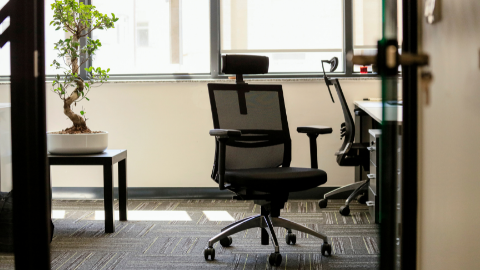
Comfort and good posture are vital to being more productive at work, even if you’re working from home.
That’s why it’s recommended to invest in an adjustable office chair, if possible.
If the chair has all of the functionality that I describe in this section, you should fully adjust the chair first and test its overall fit before purchasing a new chair.
5 Office Chair Adjustments
There are only five major chair adjustments you need to make to fit you like a glove.
- Seat Pain Height: Your feet should be resting flat on the floor and your knees are slightly lower than your hips.
- Seat Pan Depth: There should be a two to a four-inch gap between your knees’ back and the chair’s front edge when your back is flush against the backrest.
- Lumbar Support Height: Adjust the height of your chair’s lumbar support so the chair fits comfortably into the S curve of your lower back.
- Backrest Tilt: Make sure that your chair is upright and tilted slightly back.
- Armrest Height: Adjust the armrests so that they’re slightly below your elbows with your shoulders relaxed. And make sure that the armrest doesn’t interfere with your access to keying, mousing, and writing.
Work From Home Laptop Setup
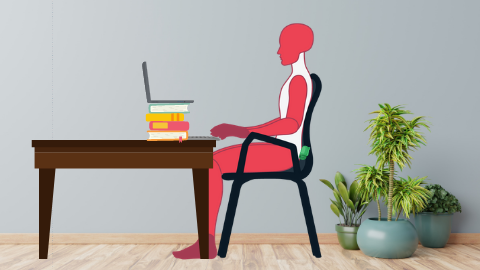
When working from home, there’s often a mismatch between your chair’s height and desk height, making it challenging to keep your elbows close to your body.
So, if you don’t have an adjustable chair, you’ll need to get creative.
One solution is to elevate your seat with pillows or cushions, support your low back with a rolled-up towel or lumbar pad, and then raise your laptop on the textbooks, so your monitor is closer to eye level.
In this scenario, you’ll need an external keyboard and mouse.
Sciatica/Coccyx Cushion

Flat, hard, and even traditionally padded seating surfaces can cause pressure on your coccyx or tailbone. This can cause improper spine alignment, decreased blood circulation, and pinched nerves.
Using a memory foam seat cushion with a contoured coccyx space can help eliminate back pain by reducing focus, body, weight pressure directly on the tailbone. The contour distributes your body weight across the entire seat, allowing your tailbone to float in the open space.
Workspace Organization
When it comes to organizing your workspace, you should arrange it so that there’s no need to overreach in any direction. Try and declutter and clear up your space.
Overreaching, bending, and twisting can cause fatigue, reduce overall productivity and increase your risk of an overuse injury. All work that you continuously do from your elbows to your fingertips, like using your keyboard and mouse, should be done in your primary work zone.
From your shoulder to your fingertips, your secondary zone is reserved for reaching for frequent things but not constant.
And all the things you have to get up for occasionally should be in your tertiary zone.
Recognize Opportunities to Move Around

Recognize opportunities to get out of your chair and move around. A Cornell University study recommends 20-8-2. Twenty minutes of sitting, 8 minutes of standing, and 2 minutes of moving.
Instead of leaning back in your chair to take that phone call, stand up and take it. Or better yet, walk and talk. Moving around keeps your blood flowing and prevents muscle fatigue and cramping.
Change it up and try working in a different area, such as with a standing desk. This helps to decrease fatigue, and it helps take the pressure off your lower back.
Remember these three tips when using a standing desk, even if it’s an ironing board.
- Your monitor height should be slightly lower than your eye height and tilted back 15 degrees.
- Your desk height should be slightly lower than your elbow height when it’s bent approximately 90 degrees.
- When in a standing workspace, stand on something soft or wear running shoes.
Your Best Posture Is Your Next Posture
In ergonomics, they like to say, “Your best posture is your next posture.”
So, tune into your body. When your fanny says it’s been sitting too long, you stand. And when your feet say they’ve been standing too long, you sit.
